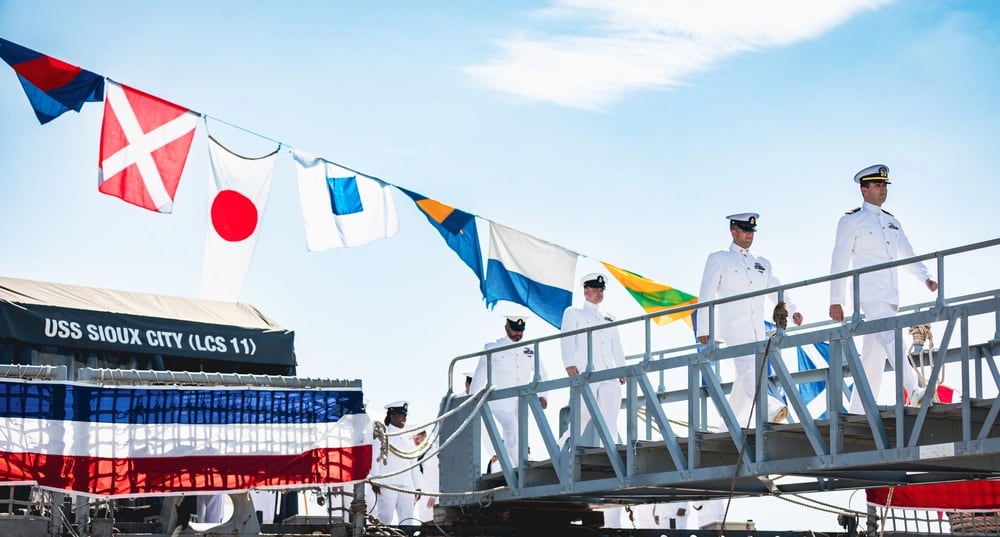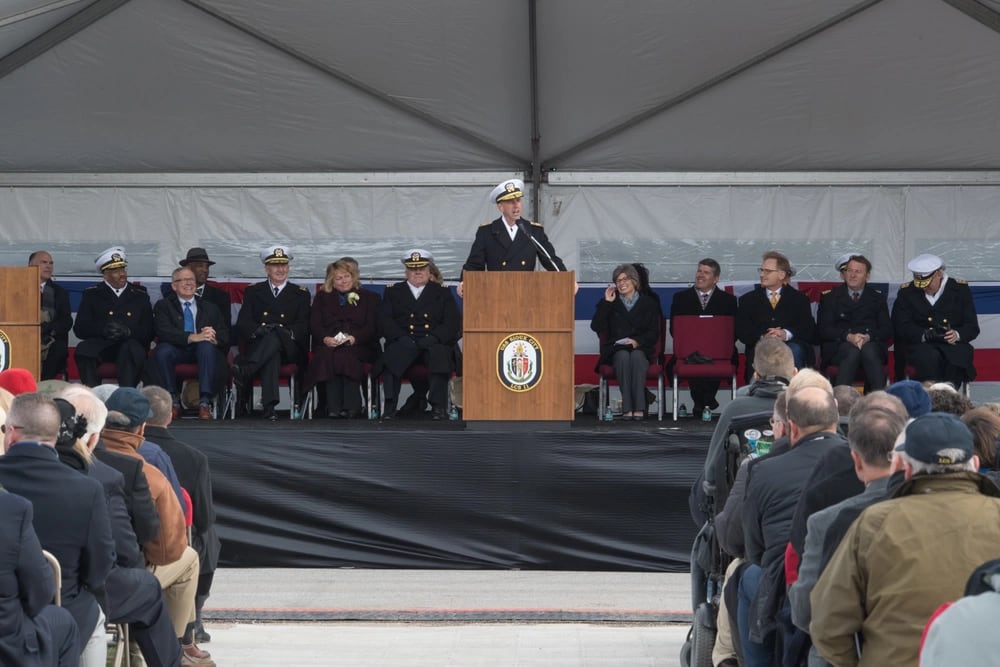When the Navy decommissioned the littoral combat ship Sioux City last month after less than five years in service, Navy officials framed it as a difficult choice that would save the service money and allow it to focus its efforts on ships that could survive a naval battle with another advanced military.
But in Sioux City, Iowa, the $460 million ship’s namesake, some local leaders felt slighted by the Navy’s mothballing of the LCS.
Far from the Beltway and catchphrases like “high-end fight” and “near-peer competition,” local media reports indicate the ship’s mothballing has been a bitter pill to swallow for some in Sioux City, while raising questions about the future of money raised in support of the ship and its crew.
Mayor Bob Scott told Radio Iowa last month that roughly $1.5 million was raised, mostly from area residents and businesses, to contribute to the Sioux City’s 2018 commissioning ceremony and to establish a crew scholarship program.
“We went out and raised a lot of money,” Radio Iowa quoted Scott as saying in an Aug. 15 report.
“There were all kinds of Sioux City citizens there, because the community got behind that and did a great job of showing the Navy how proud we were to have a ship named after us,” he said. “And then this is what the Navy does to us in return.”
RELATED

Scott said the Navy’s LCS program essentially fleeced his community, and American taxpayers in general, according to the report.
Billed as a key cog of the Navy’s surface force, the pricey LCS fleet has become an acquisitions boondoggle. The ships never took on the mission for which they were envisioned and the service is now trying to jettison littoral combat ships as fast as Congress will allow.
The Navy continues “to roll (LCS) out knowing that they’re supposedly a problem and wasting taxpayers’ money,” Scott said. “But not only that, selling that community on 30 years’ worth of commitment to that ship.”
Scott declined further comment when contacted by Navy Times.
In a statement, Navy officials said the service has to make “difficult decisions on how to invest in the future.”
“To maintain our strategic advantage, particularly under fiscal constraints, it is important for the Navy to carefully review our force structure regularly and divest of legacy capabilities that no longer bring sufficient lethality to maximize our effectiveness in deterring and defeating potential adversaries,” Naval Surface Forces officials said in a statement to Navy Times.
RELATED

“I understand budgets, I understand all of that, but I was hoping we would have at least 25 more years of USS Sioux City and the relationship,” City Council member Dan Moore told NBC affiliate KTIV last month. “The relationship was so important. All of us had built personal relationships with the U.S. Navy crew.”
In addition to the ship’s $460 million price tag, the Freedom class of LCS to which Sioux City belonged suffered an issue with defective combining gear that cost between $8 million and $10 million per ship to fix, with taxpayers footing roughly half of that cost, Breaking Defense reported in July.
Navy officials confirmed that Sioux City’s combining gear was repaired before it was retired.
The future of the money raised by the community for the ship and its crew remains unclear.
The USS Sioux City Commissioning Committee was chaired by retired Rear Adm. Frank Thorp, who served as the Navy’s chief of information before his retirement in 2009.
Thorp declined comment for this report via a spokesperson at the nonprofit United States Navy Memorial, where he serves as president and CEO.
Siouxland Chamber of Commerce President Chris McGowan told Navy Times Wednesday that money raised for the educational scholarship program to benefit Sioux City’s crew was placed in a nonprofit community foundation when the ship was commissioned.
“Subsequently, this charitable organization has promoted and provided scholarships to members of the crew on an annual basis,” McGowan said in an email. “In the wake of the much earlier than anticipated decommissioning of the USS Sioux City, the funds will remain with this foundation until such time as their board of directors, in consultation and cooperation with those who helped establish the scholarship fund, are able to meet and determine the most appropriate path forward.”
In a November 2017 Sioux City Journal report, Thorp said he appreciated gifts from the local community and that the commissioning committee was looking to raise between $800,000 and $1 million toward the commissioning, which took place in Annapolis, Maryland, on Nov. 17, 2018.
In that 2017 report, Thorp lauded a “generous contribution” from a local business and noted how it would “lay the foundation for the decades-long relationship between the ship and the namesake city.”

That article notes that some of the funds raised would go toward education expenses for Sioux City crew members, while other monies would be used to pay for costs associated with the ship’s commissioning, as federal funds cannot be used for such efforts.
Such nonprofit commissioning committees are separate from the Navy but partner with the service in planning and executing commissioning ceremonies and attendant festivities, as well as support in the form of scholarships and other efforts, according to the sea service.
Sioux City is believed to have had the briefest Navy career of any ship since the 1940s, according to a list of short-serving ships provided by officials.
The Navy announced its intent to decommission Sioux City and eight other Freedom-class LCS early in the spring of 2022, part of a move to divest the sea service of as many LCS as possible in order to free up funding for other priorities, a tacit acknowledgement that the LCS fleet has not done what it was originally envisioned to do.
The ships have also provoked congressional ire in recent years.
During a hearing last summer, Rep. Jackie Speier, D-Calif., displayed a floor chart titled “Leaking Cracked Ships” that contained a picture of each LCS with a lemon, playing on the slang for a defective vehicle.
“We all know what lemon cars are. We have a fleet of lemon LCS ships,” she said at the time. “We have spent billions of dollars on this fleet when they have no capability to help us deal with our largest threat, which is that of China and Russia. The only winners have been the contractors on which the Navy relies for sustaining these ships.”
Geoff is the managing editor of Military Times, but he still loves writing stories. He covered Iraq and Afghanistan extensively and was a reporter at the Chicago Tribune. He welcomes any and all kinds of tips at geoffz@militarytimes.com.





